Petitioner with Children
California Divorce Form FL-110
The Summons (FL-110) initiates your divorce lawsuit–it sounds scarier than it really is.
In our last divorce form tutorial, we covered the petition, known as form FL-100. Next, we have form FL-110, also known as the summons. This form scares a lot of people for a number of reasons, but the first thing to understand is that it’s extremely easy to fill out. Half of the form content is in Spanish, so it looks twice as long as it actually is. It has a lot of important content that requires some time to read through, but start to finish should take no more than 5 minutes. Download the form and let’s get started.
Petitioner & Respondent

FL110: Petitioner and Respondent
First, a review on petitioner and respondent. Since you’re the individual completing these forms and initiating the divorce process, you are the petitioner. Therefore, the respondent would be your spouse, and you are going to place your spouse’s name in this field. Using our example couple, John and Jane Smith, Jane’s name would go here.
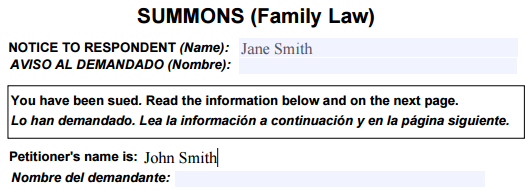
FL110: Petitioner and Respondent filled
You’ll notice in the box below Notice to Respondent, it mentions, “You have been sued…” This is a notice to the respondent (your spouse), or in the example case, Jane. It sounds scary and horrible, but in reality a divorce is a lawsuit – just like any other court case. Remember, California is a no-fault state when it comes to divorce, so the parties involved are referred to as petitioner and respondent instead of plaintiff and defendant.
Next, we’re going to go down to the following field which is, “petitioner’s name is:” You are the petitioner, and you’re going to input your name here.
The Fine Print
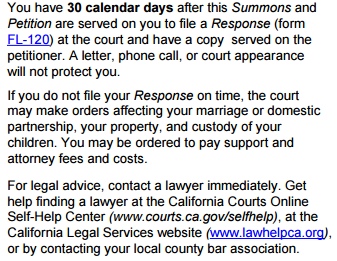
FL110: Fine Print
Page 1 has information which is mostly intended for the respondent. Remember, in our sample case, Jane is the respondent. In your case, your spouse is the respondent. It’s important for you to read this information. Essentially what it says is, “the respondent has 30 days to file a response to the petition once it’s been served on them.” Beyond that, if you have further questions, you can read it more thoroughly and you’ll see they provide a website where you can get more information.
1. Court Address
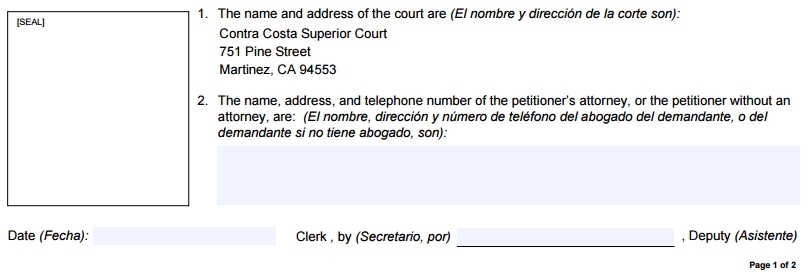
FL110: Court Address
Moving forward, we’re going to scroll down and arrive at the part that you need to actually fill out – the name and address of the court. In our sample case, petitioner John is in Contra Costa County so we have Contra Costa County Superior Court, 751 Pine Street, Martinez, California, and the zip code is 94553.
2. Name, Address, & Phone of Petitioner (or Petitioner’s Attorney)
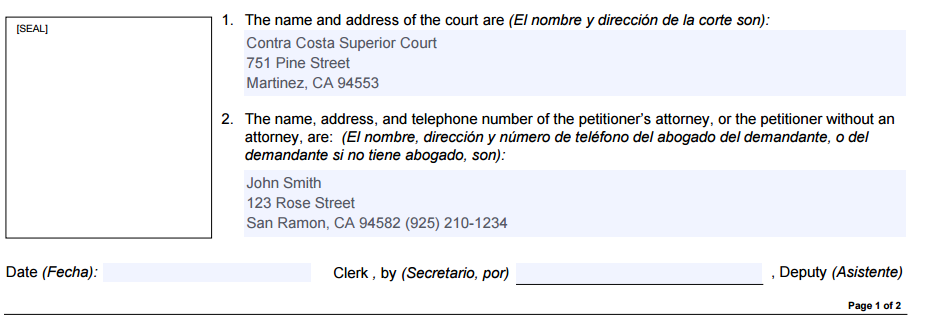
FL110: Petitioner Information
You’re not an attorney, but you are the petitioner without an attorney, so you’re going to put your name and address. As I mentioned previously in completing FL-100, the petition, you don’t need to put your home address, but you do need to put a valid mailing address where the court can reach you.
Page 2
On page 2 of the summons there is absolutely nothing for you to fill out, but it is extremely important that you read and understand the material. Just like the first page – half of it is Spanish, half of it is English, so it’s not nearly as much reading as you think it is going to be. There are a lot of scary terms just like page 1 where it mentions being sued. On this page, you’re being “restrained,” so it discusses restraining orders. The first thing to understand is these orders are not domestic violence restraining orders. We are not saying that you or your spouse have done anything bad. These orders are what I consider, “social niceties,” they are simply things that you and your spouse are not supposed to do between now and the time the divorce judgment is entered, unless you two have a written agreement otherwise.
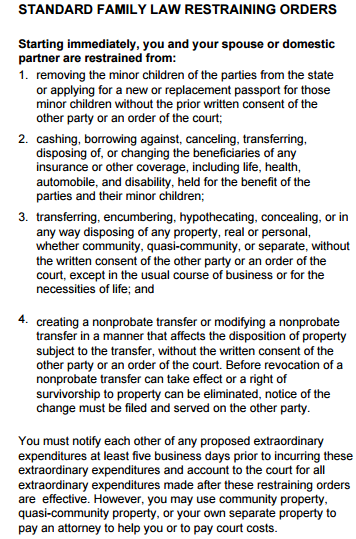
FL-110: Standard Family Law Restraining Orders
Number 1: In case you and your spouse have minor children of your marriage, you cannot remove that child from the state of California without written permission from the other parent, or a court order. Nobody wants any parental kidnapping. Nobody wants kids being scared during this divorce process, so in this regard, keeping the child in California makes a lot of sense. Keep in mind, this order does not apply to you, only the kids. If you have a business trip out of state, feel free to go. If you want to go out for a weekend with your friends, by all means – go. It simply states your child has to stay here in California.
Number 2: Cashing, borrowing against, canceling, transferring, disposing of, or changing the beneficiary of any insurance or other policy. This includes life insurance, health insurance, auto insurance – all of the insurance policies that you can think of. Do not change the beneficiaries. I don’t recommend you try to do or change anything. The main reason is because we don’t want somebody without insurance – your spouse, and especially the kids, even if they’re removed accidently. Even if you’re paying out of pocket, or paying premiums through your paycheck every month, do not change the beneficiaries. You wouldn’t want it done to you, so we’re going to ask you not to do it to anyone else.
Number 3: Transferring, encumbering, hypothecating, concealing, or in any way disposing of any property, real or personal without the consent of the other spouse. This one can by tricky, and probably the one that I receive most of the questions on. Sometimes number 3 results in unfair dealings. Can I take my spouse off the credit card? No. Can I take my spouse’s name off the bank account? No. Can I sell my stock? No. You are not supposed to do anything outside the ordinary course of business without your spouse’s permission or written consent. This one also goes back to a social nicety – it’s something that you need to do, and it’s the right thing to do. I understand that your credit can get damaged and some unfair ramifications could result, but you really need to keep this intact. The courts take violations of these restraining orders seriously, and it usually costs you a whole lot more to undo what you did. The idea is to freeze everything as close to what it looked like during your marriage as possible.
Number 4: Creating a non-probate transfer. This action is one of those things that is very unlikely to occur, but it essentially states that you don’t want to give away property. That’s the best way to explain it. You don’t want to try and cheat your spouse out of what is considered joint property, or even property in your own name. Additionally, you need to notify the other person of any proposed extraordinary expenditures at least 5 days in advance. If the pipes break in your house and it’s going to cost a really large amount of money to fix, you need to notify your spouse. It’s not necessarily asking for permission, but you do need to notify, because again, a lot of times you have to dip into community property money and you need to notify the other party.
You may use community property, or your own separate property to pay an attorney or your court costs. That is something you can do, so you could theoretically use a community credit card to charge your attorney fees or pay your bills.
The Affordable Healthcare Act

FL110: Access to Affordable Health Insurance
You might have heard of it as Obamacare, and this section is giving you notice that you may be eligible for it. Even though you are covered through the restraining order, the automatic temporary restraining orders (ATROS), the standard family law restraining orders, you need to be thinking about the future. If you are covered by health insurance under your spouse, this is not going to happen forever. Once the divorce is finalized, you’re not related to your spouse anymore, which means he or she cannot legally cover you. So the AHA, or Covered California, is your resource that you want to get started on, and I encourage you to start looking sooner rather than later.
Warning – Important Information (the last section)
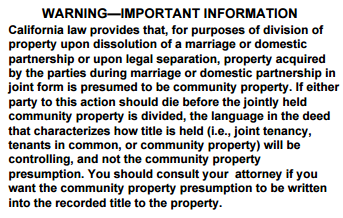
FL110: Important Information
We only recognize you in California as married or single. Once you’ve begun this divorce process, you are not divorced – you are still married. Even though you are in this funny position, what it translates to is that the law still recognizes you as legally married until the divorce judgment is entered. What does that mean for you? If you pass away without a will, it’s called, “dying intestate” and everything goes to your next of kin. In this scenario, your next of kin would be your spouse even if you’re in the middle of the divorce process. So the warning is stating that if you are concerned about this, you can always draw up a will. Remember what was mentioned above – you cannot change the beneficiaries. Do not change anything. But as far as drawing up a will, it’s something you can absolutely do.
We’re now done with the summons, form FL-110, and one step closer to being ready to file for divorce. Like I mentioned, it’s a pretty easy form to complete, but it has a lot of legal meaning and warnings.
If you have any questions about what the standard family law restraining orders mean, whether they apply to you (the answer is “yes”), please contact us. The third step is going to be the UCCJEA, which is form FL-105, and it only applies to you if you have minor children of your marriage. If you don’t have minor children of your relationship, then you’re going to skip that and move forward to the service, which is the Proof of Service of Summons, form FL-115, of the Petitioner without Minor Children path.
Petitioner with Children Path
Need Help?
Not a Petitioner with Children?
Choose the right forms based on your circumstances.
DIY Divorce Video Series
You're on the Petitioner with Children specialized track. Change your course or learn more about all of the court forms involved in a California divorce at our DIY Divorce Center. (scroll to dismiss this notice)
